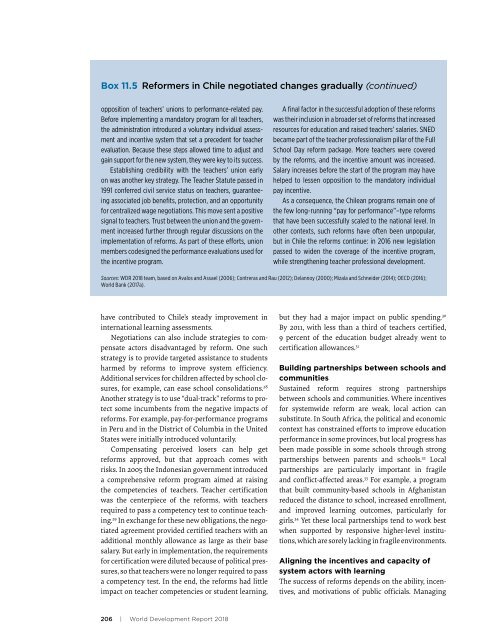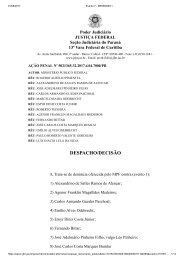Brasil só deve dominar Leitura em 260 anos, aponta estudo do Banco Mundial Relatorio Banco Mundial _Learning
You also want an ePaper? Increase the reach of your titles
YUMPU automatically turns print PDFs into web optimized ePapers that Google loves.
Box 11.5 Reformers in Chile negotiated changes gradually (continued)<br />
opposition of teachers’ unions to performance-related pay.<br />
Before impl<strong>em</strong>enting a mandatory program for all teachers,<br />
the administration introduced a voluntary individual assessment<br />
and incentive syst<strong>em</strong> that set a precedent for teacher<br />
evaluation. Because these steps allowed time to adjust and<br />
gain support for the new syst<strong>em</strong>, they were key to its success.<br />
Establishing credibility with the teachers’ union early<br />
on was another key strategy. The Teacher Statute passed in<br />
1991 conferred civil service status on teachers, guaranteeing<br />
associated job benefits, protection, and an opportunity<br />
for centralized wage negotiations. This move sent a positive<br />
signal to teachers. Trust between the union and the government<br />
increased further through regular discussions on the<br />
impl<strong>em</strong>entation of reforms. As part of these efforts, union<br />
m<strong>em</strong>bers codesigned the performance evaluations used for<br />
the incentive program.<br />
A final factor in the successful a<strong>do</strong>ption of these reforms<br />
was their inclusion in a broader set of reforms that increased<br />
resources for education and raised teachers’ salaries. SNED<br />
became part of the teacher professionalism pillar of the Full<br />
School Day reform package. More teachers were covered<br />
by the reforms, and the incentive amount was increased.<br />
Salary increases before the start of the program may have<br />
helped to lessen opposition to the mandatory individual<br />
pay incentive.<br />
As a consequence, the Chilean programs r<strong>em</strong>ain one of<br />
the few long-running “pay for performance”–type reforms<br />
that have been successfully scaled to the national level. In<br />
other contexts, such reforms have often been unpopular,<br />
but in Chile the reforms continue: in 2016 new legislation<br />
passed to widen the coverage of the incentive program,<br />
while strengthening teacher professional <strong>deve</strong>lopment.<br />
Sources: WDR 2018 team, based on Avalos and Assael (2006); Contreras and Rau (2012); Delannoy (2000); Mizala and Schneider (2014); OECD (2016);<br />
World Bank (2017a).<br />
have contributed to Chile’s steady improv<strong>em</strong>ent in<br />
international learning assessments.<br />
Negotiations can also include strategies to compensate<br />
actors disadvantaged by reform. One such<br />
strategy is to provide targeted assistance to students<br />
harmed by reforms to improve syst<strong>em</strong> efficiency.<br />
Additional services for children affected by school closures,<br />
for example, can ease school consolidations. 28<br />
Another strategy is to use “dual-track” reforms to protect<br />
some incumbents from the negative impacts of<br />
reforms. For example, pay-for-performance programs<br />
in Peru and in the District of Columbia in the United<br />
States were initially introduced voluntarily.<br />
Compensating perceived losers can help get<br />
reforms approved, but that approach comes with<br />
risks. In 2005 the In<strong>do</strong>nesian government introduced<br />
a comprehensive reform program aimed at raising<br />
the competencies of teachers. Teacher certification<br />
was the centerpiece of the reforms, with teachers<br />
required to pass a competency test to continue teaching.<br />
29 In exchange for these new obligations, the negotiated<br />
agre<strong>em</strong>ent provided certified teachers with an<br />
additional monthly allowance as large as their base<br />
salary. But early in impl<strong>em</strong>entation, the requir<strong>em</strong>ents<br />
for certification were diluted because of political pressures,<br />
so that teachers were no longer required to pass<br />
a competency test. In the end, the reforms had little<br />
impact on teacher competencies or student learning,<br />
but they had a major impact on public spending. 30<br />
By 2011, with less than a third of teachers certified,<br />
9 percent of the education budget already went to<br />
certification allowances. 31<br />
Building partnerships between schools and<br />
communities<br />
Sustained reform requires strong partnerships<br />
between schools and communities. Where incentives<br />
for syst<strong>em</strong>wide reform are weak, local action can<br />
substitute. In South Africa, the political and economic<br />
context has constrained efforts to improve education<br />
performance in some provinces, but local progress has<br />
been made possible in some schools through strong<br />
partnerships between parents and schools. 32 Local<br />
partnerships are particularly important in fragile<br />
and conflict-affected areas. 33 For example, a program<br />
that built community-based schools in Afghanistan<br />
reduced the distance to school, increased enrollment,<br />
and improved learning outcomes, particularly for<br />
girls. 34 Yet these local partnerships tend to work best<br />
when supported by responsive higher-level institutions,<br />
which are sorely lacking in fragile environments.<br />
Aligning the incentives and capacity of<br />
syst<strong>em</strong> actors with learning<br />
The success of reforms depends on the ability, incentives,<br />
and motivations of public officials. Managing<br />
206 | World Development Report 2018








